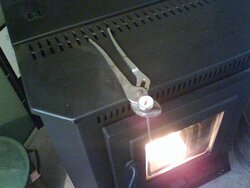I have an Englander 25 PVDC with an OAK, and over 6ft of vertical (exterior) pipe. I have been burning Fire side ultra all year. I have never really needed anything over 5,5 for a burn setting. Usually I get home from work, clean and fire it up, 3,3. house is brought up 56F to 62F from furnace and the pellet stove will steadily increase to 65F or so (next room over) At night I bring it down to 2,2 or maybe even 1,1 to keep the house just above 60F (this is what the furnace is set at). This is with an outdoor 28F during daylight about maybe 18F at night. My house is a single level 1100sqft ranch, with fair insulation. aslo my low feed setting is 4,5,1 which I set for best burn.
I have noticed as of late that I need to bump up the setting a little more now, and anything above 5,5 just does not seam to really help. Last night it was 33F outside so I put the stove on 3,3 and it never even got above 62F in the next room over, in the beginning of the season I would have been up to 70F no prob.
I have burned a little over a ton and it probably needs a real good clean, blowers removed and the vent pipe cleaned. I was wondering if others use the higher settings with any good results, and if I really need to take the time to do a full tear down clean.
my cleaning routine is every other day vac and scrape burnpot and auger tube. Weekly, take off impingement baffle and vacuum behind that. Then maybe every two weeks vac/scoop all ash out of bottom section.
I have not pulled the exhaust blower, room blower, or cleaned the vent pipe.
I plan on getting a probe temp to give me a better idea of the heat output.
I have noticed as of late that I need to bump up the setting a little more now, and anything above 5,5 just does not seam to really help. Last night it was 33F outside so I put the stove on 3,3 and it never even got above 62F in the next room over, in the beginning of the season I would have been up to 70F no prob.
I have burned a little over a ton and it probably needs a real good clean, blowers removed and the vent pipe cleaned. I was wondering if others use the higher settings with any good results, and if I really need to take the time to do a full tear down clean.
my cleaning routine is every other day vac and scrape burnpot and auger tube. Weekly, take off impingement baffle and vacuum behind that. Then maybe every two weeks vac/scoop all ash out of bottom section.
I have not pulled the exhaust blower, room blower, or cleaned the vent pipe.
I plan on getting a probe temp to give me a better idea of the heat output.


